
These 10 buildings tell the story of L.A.’s Roaring 1920s, year by year
Los Angeles may be notorious for ignoring history and reinventing itself at breakneck speed, but there are exceptions. And some of them take up entire city blocks.
A startling number of L.A. County’s most inspiring and entertaining structures went up in 1920s.
L.A. City Hall, the downtown Central Library and the (much-amended) Hollywood Bowl are three of that era’s most famous buildings, and the Hollywood sign (1923) and Watts Towers (begun in 1921) date to the same decade.
Planning your weekend?
Stay up to date on the best things to do, see and eat in L.A.
But beyond those familiar favorites, there are dozens of other remarkable buildings that went up between 1919 and 1930, as Los Angeles was passing San Francisco as the West’s biggest city.
How busy were builders? The county’s population jumped from 936,000 to 2.2 million in that decade.
This year-by-year tour covers 10 of the most admired and emblematic among those buildings. They’re not all works of cutting-edge architecture, but they are enduring parts of the region’s character. They’re also a reminder that despite the many elements that made the Roaring ‘20s unique, there are always rhymes in history.
A century ago, the influenza epidemic of 1919 was a fresh memory. Movies and radio were disrupting pop culture. And plenty of people were nervous about the coming ’32 Olympics.
And now? Here we are, struggling to climb out of a pandemic, reckoning with the advent of artificial intelligence and nervous about the coming ’28 Olympics.
And where will those Olympics be held? The 1923 L.A. Memorial Coliseum, of course.
Here’s the tour. — Christopher Reynolds
Lisa Boone contributed to this report.
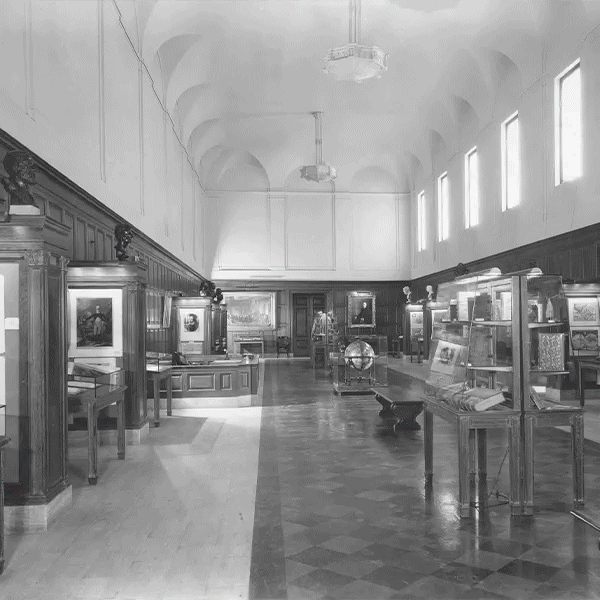
1920: Huntington Library
The Huntingtons chose a beaux-arts design by Myron Hunt — a stately home for a book collection that was already close to 1 million volumes, including a Gutenberg Bible. To bring books and other treasures west from New York, current Library Director Sandra Brooke Gordon notes, Henry Huntington built a railroad spur to the property. Behind tall bronze doors, the 230-foot-long reading room featured floor of marble and cork, oak wainscoting, 30-foot coved ceilings and a set of windows on the south side — which, librarians soon realized, let in far too much light for a delicate book collection.
Now: By 1934 the windows were walled over, researchers had been rerouted elsewhere and the space had been converted into an exhibition area. Later an interior balcony and more shelves appeared and the Huntington re-created three lost chandeliers. Thousands of visitors per month now pass through the Exhibition Hall, peering at early editions of Chaucer and Shakespeare, manuscripts of Octavia Butler, Henry David Thoreau and many more. The collection, spanning 10 centuries, now approaches 12 million items.
Adult admission to the Huntington is $29. Closed on Tuesdays.
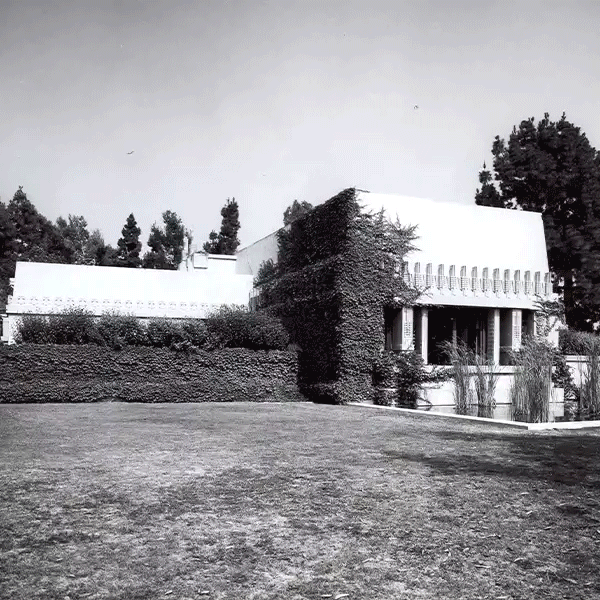
1921: Hollyhock House in Barnsdall Art Park
This was the architect’s first California commission, designed for heiress Aline Barnsdall (who loved hollyhock flowers). Wright’s ideas here may leave you agog. Concrete doors. The moat? In front of the fireplace. Wright also designed some of the furniture and windows. Assistants on the project included Wright’s son Lloyd Wright, Rudolph Schindler and Richard Neutra, all on their way to architecture stardom.
Now: Much of this 6,000-square-foot residence is open for self-guided tours, with docents on hand with details on the mercurial Wright and his client (who fired him in the end). The home, protected as a UNESCO World Heritage site, is the centerpiece of Barnsdall Art Park. From there you can see the Hollywood sign (which didn’t exist in 1921) and another notable Wright building, the 1924 concrete-block Ennis House in Los Feliz.
Hollyhock House is open 11 a.m. to 4 p.m. Thursday through Saturday, and tickets are $7 per adult (seniors $3; free for under 18 with a paying adult).
Grassy areas on the hilltop are available for picnicking, and the neighboring Los Angeles Municipal Art Gallery is free to visit. The park also includes a theater and an arts center. In summer there is Friday night wine tasting with DJs and food trucks on the West Lawn.
Also in 1921: Sabato (a.k.a. Simon) Rodia begins building the Watts Towers .
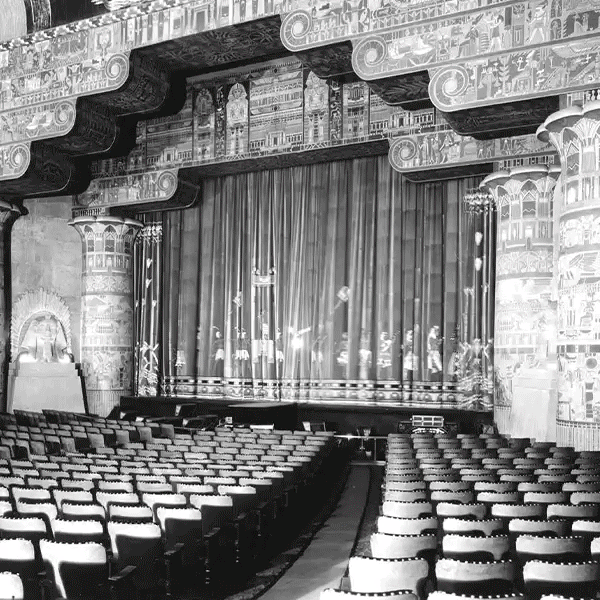
1922: The Egyptian Theatre
Audiences passed from Hollywood Boulevard into an open-air forecourt. Hieroglyphics and lanterns marked the walls, which were sculpted to resemble stacked stone blocks. A sunburst design dominated the ceiling. Golden swans floated above the screen. (Five years later, Grauman would open his famed Chinese theater down the street.)
Now: Elaborately restored after a 2020 purchase by Netflix, the Egyptian Theatre reopened in November. Almost all of the old flourishes have been retained (but not the “harem girl” ushers of 1922). The theater holds just over 500 seats. Over the years, a balcony was added, then subtracted.
The American Cinematheque programs the theater on Friday-Sunday with hits such as “Boogie Nights,” “Crooklyn” and “Forrest Gump” (all in August). Netflix does the programming Monday-Thursday and has a merch shop next door.
Tickets to shows are typically $15-$20. The Egyptian has no dedicated parking.
Also in 1922: The Hollywood Bowl opens. The Schindler House (a.k.a.Kings Road House) is completed in West Hollywood. The Rose Bowl is completed in Pasadena. The Tam O’Shanter (known as Montgomery’s Country Inn until 1925) opens in Atwater Village.
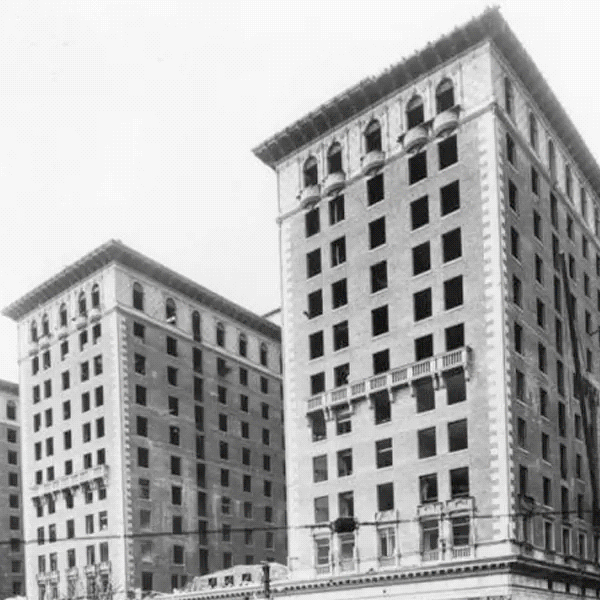
1923: Biltmore Hotel
Now: The Biltmore’s days of hosting U.S. presidents, foreign dignitaries and the Academy Awards may be over, but visitors can still experience its over the top opulence. Even now, every surface appears to be painted, carved or gilded. Soak up the vibes in the darkly ornate Gallery Bar and Grill, where the cocktails are expensive but the popcorn is free. (The ambiance is only slightly tainted by two flat screen TVs.) The hotel also hosts a formal afternoon tea on Saturdays from 2-5 p.m. in what was once the main lobby. (Reservations are recommended). Or just show up and explore the building’s broad, beautifully decorated hallways and peek into any ballroom that might be open. (Keep an eye out for a Biltmore inspired dress.) The complimentary fruit-infused water in the lobby is very refreshing on a hot day.
Also in 1923: The Hollywood sign is erected in the hills of Beachwood Canyon (it read “Hollywoodland” at the time), the Los Angeles Memorial Coliseum is completed, and preacher Aimee Semple McPherson’s Angelus Temple opens its doors on New Year’s Day.
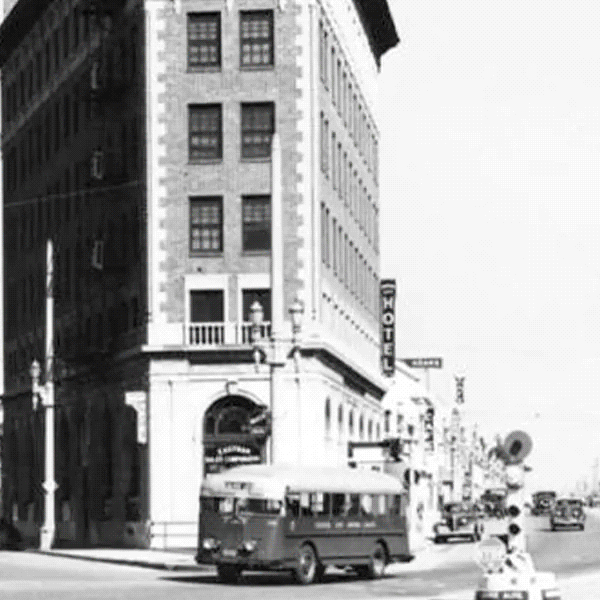
1924: The Culver Hotel
Advertised as Culver City’s first skyscraper when it opened a few blocks from MGM Studios, the hotel has its fair share of Hollywood lore. John Wayne once owned the building and Greta Garbo, Clark Gable and Buster Keaton all kept apartments there. Most famously, MGM put up the 124 actors who played the Munchkins at the hotel when they were shooting “The Wizard of Oz.”
Now: Step into the Culver Hotel’s grand, double height lobby with its large arched windows and pillars topped with gold leaf, and you’ll feel instantly transported not just to a different century, but a different continent. Is this L.A. or a beaux-arts hotel in Paris? Fortunately, you don’t need to book a room to experience the Culver Hotel’s historic glamour. The in-house restaurant Lillie’s is open from 7 a.m. to 10 p.m. Sun-Thurs. and until 12 a.m. Friday and Saturday.
If you visit during the day consider enjoying an Arnold Palmer in the dappled shade alongside the building’s sculpted stone and brick exterior, or grab a coffee and a comfy chair in the beautifully restored lobby. On weekend nights the hotel is louder and more boisterous hosting swing bands and burlesque shows in the lobby and DJs in the second floor speakeasy. Check the website for details.
Also in 1924: Frank Lloyd Wright’s beloved Mayan Revival Ennis House in Los Feliz.
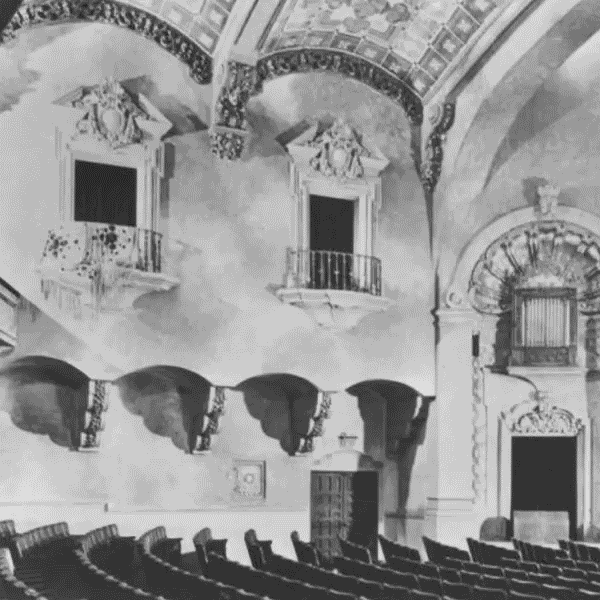
1925: Pasadena Playhouse
By 1939, playhouse leader Gilmor Brown had staged all 38 of Shakespeare’s plays, won designation as the state’s official theater, and had ventured into edgier contemporary material with a production of “Our Town.”
The theater’s courtyard served as an outdoor lobby, shaded by palm and fig trees. Indoors, above the seats, the ceiling seemed to be adorned with Spanish-style hand-painted tiles.
Now: Outside, the palms and fig stand tall. Inside, that strange ceiling remains — but as Pasadena Playhouse producing artistic director Danny Feldman enjoys revealing, it’s an illusion — lightweight burlap, painted to look like tiles. Someday, Feldman hopes, audiences will again see the stage’s asbestos fire curtain, which features an epic painting of a Spanish galleon by California impressionist Alson Clark. (For now the curtain awaits restoration.) It’s easy, once inside, to forget the venue’s patchy history, including a closure from 1969 to 1986 and a bankruptcy in 2010. In 2023, the Playhouse won the Tony Award as the nation’s top regional theater.
The theater seats about 640. The company’s 2024-25 season begins Sept. 4 with “Cyrano de Bergerac.” Tickets start at $40.
Also in 1925: L.A. County’s Hall of Justice is completed downtown.
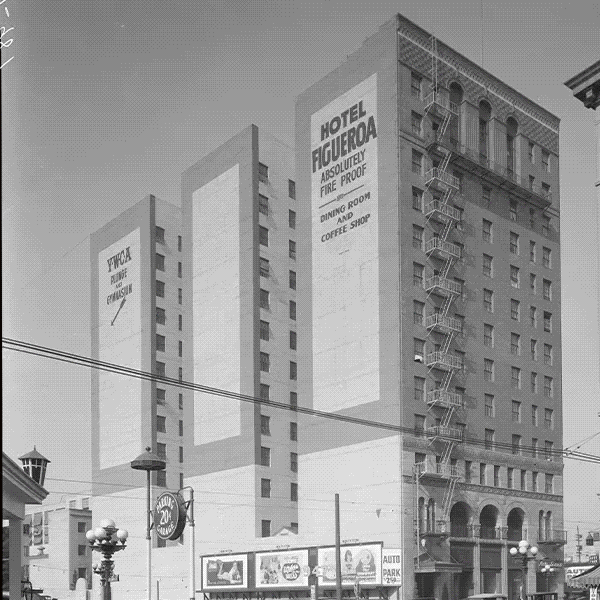
1926: Hotel Figueroa
When it opened in the summer of 1926 the L.A. Times called the building “the largest project of its kind to be financed, built, owned and operated by women.” In the early years nine of the hotel’s 14 floors were reserved for women and it was run by the boundary-breaking Maude N. Bouldin, who flew planes, rode motorcycles and was reportedly the first female hotel manager in the United States.
Now: The Hotel Figueroa’s time as a female-centered hideaway didn’t last long. The YWCA sold the building after the crash of 1929 and by 1930 all floors were open to all sexes. It became a semi-permanent residential hotel in the 1960s before being reimagined in 1976 as a dimly lighted, Moroccan-themed retreat. The hotel’s most recent overhaul, completed in 2018, restored its Spanish Colonial roots without making it feel like a period piece.
You don’t need a reservation to visit the soaring lobby with beamed ceilings, dark wood wainscoting and leaded windows. An arched hallway leads to the pool area, but you’ll need a room key to swim. If you visit, keep an eye out for the inverted triangle motif that appears throughout the building. It’s a symbol of feminine leadership and was part of the YWCA’s original logo.
Also in 1926: The L.A. Central Public Library opens, the 6,300-seat Shrine Auditorium, the MacArthur originally a private club in Westlake, Julia Morgan’s Los Altos Apartments and Lloyd Wright’s Sowden House.
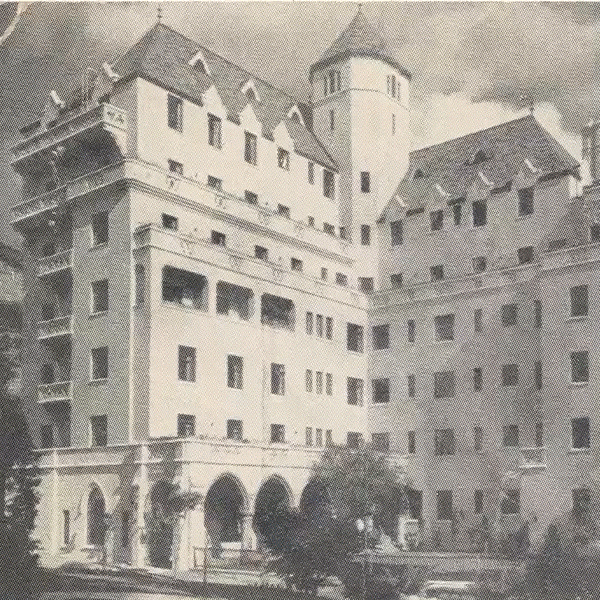
1927: Chateau Marmont
Unfortunately for Horowitz, the stock market crashed eight months after the Chateau opened its doors in 1929. He sold it in 1932 to film pioneer Albert E. Smith, who transformed the building into a hotel while keeping the kitchens intact. The Chateau Marmont quickly became a favorite home away from home for actors, directors, writers and musicians for nearly a century. As filmmaker Billy Wilder famously said: “I would rather sleep in a bathroom than in another hotel.”
Now: Booking a room in the Chateau Marmont is prohibitively expensive for most of us, but there are other ways to visit Horowitz’s French-Gothic fantasy. Anyone can make a reservation at the hotel’s restaurant, where you can soak up its storied vibe and concrete archways while dining at woven bistro tables beneath cream and crimson Moroccan-inspired tents. (On a recent visit the lighting and service were impeccable. The food was fine.) After dinner you can retire to the hotel’s dimly lighted lobby, where heavy wooden tables, textured walls and large brocade-covered chairs evoke a fancy living room.
Also in 1927: The Mayan Theatre and the United Artists Theater open in downtown, Pasadena City Hall, and Hollywood’s TCL Chinese Theatre although it was just the Chinese Theater back then.
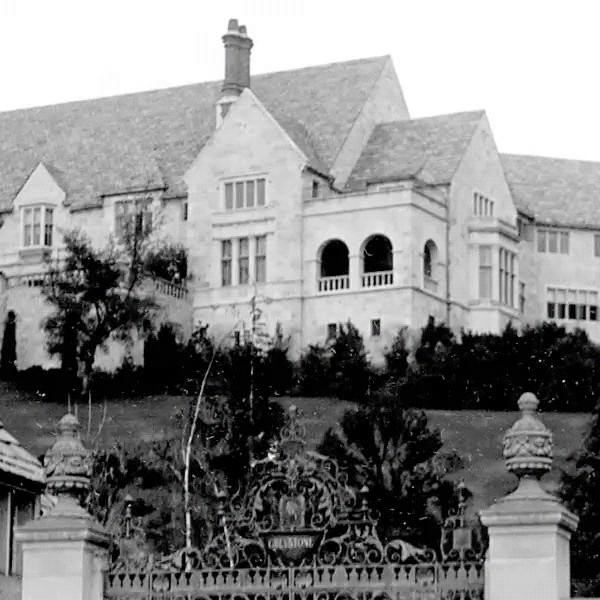
1928: Greystone Mansion and Gardens
But there’s no masking the mansion’s dark history. On Feb. 16, 1929, five months after heir Edward Doheny Jr. had moved in with his wife, Lucy, and their five children, the bodies of Doheny and his secretary, Hugh Plunkett, were found in the house, fatally shot. Authorities ruled that Plunkett killed his employer and then himself, but speculation continues.
Now: It’s not just a mansion and crime scene. It’s one of SoCal’s most popular filming locations (“There Will Be Blood” and “The Big Lebowski,” among many others) and it’s a public park.
The grounds, open daily from 10 a.m. to 5 or 6 p.m. (depending on the season), include several water features. Self-guided indoor tours of the first floor and theater are available on Saturday or Sunday during the first weekend of each month.
Tour tickets are $8 for Beverly Hills residents, $10 for nonresidents and must be purchased in advance. (Upcoming dates: Sunday, Aug. 4, and Saturday, Sept 7.)
Also in 1928: Los Angeles City Hall and the Oviatt Building are completed in downtown L.A. The Dunbar Hotel opens on L.A.’s Central Avenue.
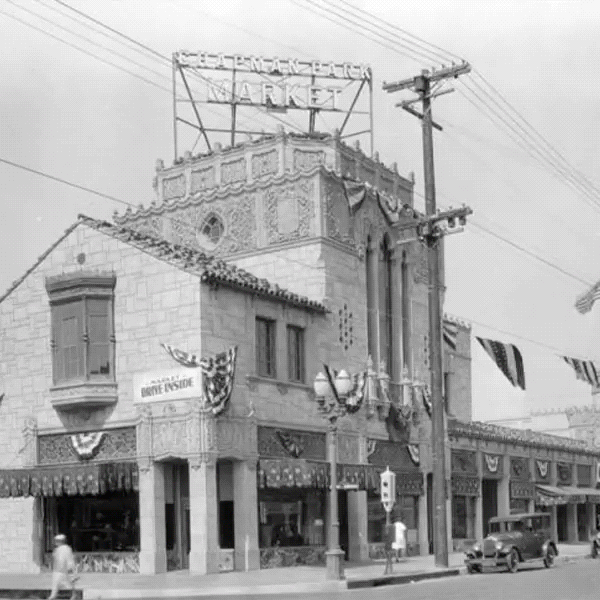
1929: Chapman Market
Designed by architects Morgan, Walls and Clements, who also designed the Wiltern Theatre, the market’s other innovations included a sound system that announced bargains throughout the day and a central refrigerating system. The three-day grand opening included performances by a symphony orchestra and a troupe of Russian dancers.
Now: To enter Chapman Market today is to step into an alternate version of Los Angeles where the city’s historic buildings were not knocked down and replaced, but instead allowed to evolve and adapt to their neighborhood’s changing realities. The red tile roof, turret and crazily carved granite remain, but today the market’s vendors reflect the modern tastes of its Koreatown neighbors.
In the same storefronts where grocers once sold vegetables, meat and flowers, you’ll find two well-regarded Korean barbecue restaurants, a Boba store, a Japanese cosmetic store and a Starbucks. Neon signs illuminate the elegant arches in this beautiful shopping plaza where historic and contemporary L.A. collide in the best way.
Also in 1929: The lavish and stately Wilshire Boulevard Temple, Richard Neutra’s avant-garde Lovell House, the Adamson House in Malibu and the luxury department store building Bullocks Wilshire now occupied by Southwestern Law School.
Sign up for The Wild
We’ll help you find the best places to hike, bike and run, as well as the perfect silent spots for meditation and yoga.
You may occasionally receive promotional content from the Los Angeles Times.



